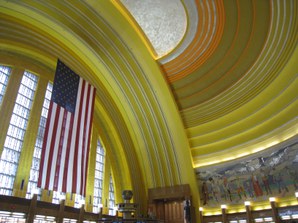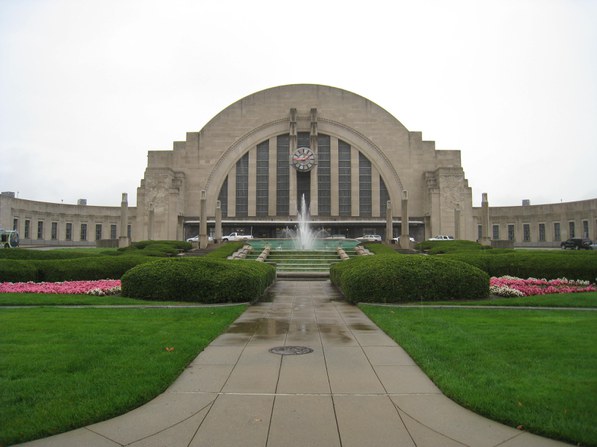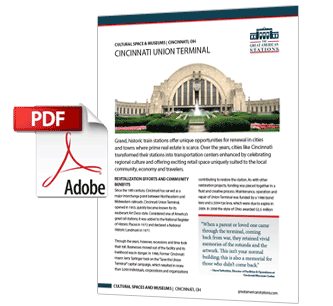Grand, historic train stations offer unique opportunities for renewal in cities and towns where prime real estate is scarce. Over the years, cities like Cincinnati transformed their stations into transportation centers enhanced by celebrating regional culture and offering exciting retail space uniquely suited to the local community, economy and travelers.
Revitalization Efforts and Community Benefits
Since the 19th century, Cincinnati has served as a major interchange point between Northeastern and Midwestern railroads. Cincinnati Union Terminal, opened in 1933, quickly became known for its exuberant Art Deco style. Considered one of America’s great rail stations, it was added to the National Register of Historic Places in 1972 and declared a National Historic Landmark in 1977.
Through the years, however, recessions and time took their toll. Businesses moved out of the facility and its livelihood was in danger. In 1986, Former Cincinnati mayor Jerry Springer took on the “Save the Union Terminal” capital campaign, which resulted in more than 3,000 individuals, corporations and organizations contributing to restore the station. As with other restoration projects, funding was pieced together in a fluid and creative process. Maintenance, operation and repair of Union Terminal was funded by a 1986 bond levy and a 2004 tax levy, which were due to expire in 2009. In 2008 the state of Ohio awarded $2.5 million in capital funds for building restoration and repair. The station’s collection of cultural organizations, known as the Cincinnati Museum Center (CMC), also mobilized staff and volunteers to encourage Cincinnatians to vote for a new tax levy to provide support of $3.3 million per year over five years.
“When a parent or loved one came through the terminal, coming back from war, they retained vivid memories of the rotunda and the artwork. This isn’t your normal building; this is also a memorial for those who didn’t come back.” – Steve Terheiden, Director of Facilities & Operations at Cincinnati Museum Center
Station as a Destination
As a masterwork of the integration of art and functionality, the well-planned Union Terminal is a monument to the memories and history of the Queen City. Over the years, Cincinnati Union Terminal grew to include attractions that welcome roughly 1.4 million visitors each year, including:
- The Cincinnati Historical Society Library
- The Cincinnati History Museum
- The Duke Energy Children’s Museum
- The Museum of Natural History and Science
- The Robert D. Lindner Family OMNIMAX® Theater
- Shops, restaurants, rental spaces
- An Amtrak ticket office and waiting room
The impact of creating the CMC at Union Terminal, as well as the Terminal’s restoration, has been economic, educational and cultural. The economic impact of normal Museum Center operations and maintenance was estimated in 2009 to be $87 million, with 1,100 jobs supported and $37 million of “new money” brought into the region by center visitors. The Union Terminal is a vital community asset for all of Cincinnati and surrounding counties in both Ohio and Kentucky.
Keys to Success
 Cincinnati Union Terminal continues to serve Southwestern Ohio because community leaders:
Cincinnati Union Terminal continues to serve Southwestern Ohio because community leaders:
- Maintained relationships with local residents and public officials, which resulted in a successful capital campaign.
- Engaged the community to approve and support a funding tax levy.
- Preserved the Art Deco design of the historic station.
- Ensured the Union Terminal served the community and Cincinnati families with educational and historic activities available year-round.




 Amtrak established the Great American Stations Project in 2006 to educate communities on the benefits of redeveloping train stations, offer tools to community leaders to preserve their stations, and provide the appropriate Amtrak resources.
Amtrak established the Great American Stations Project in 2006 to educate communities on the benefits of redeveloping train stations, offer tools to community leaders to preserve their stations, and provide the appropriate Amtrak resources. For more than 50 years, Amtrak has connected America and modernized train travel. Offering a safe, environmentally efficient way to reach more than 500 destinations across 46 states and parts of Canada, Amtrak provides travelers with an experience that sets a new standard. Book travel, check train status, access your eTicket and more through the
For more than 50 years, Amtrak has connected America and modernized train travel. Offering a safe, environmentally efficient way to reach more than 500 destinations across 46 states and parts of Canada, Amtrak provides travelers with an experience that sets a new standard. Book travel, check train status, access your eTicket and more through the